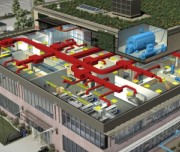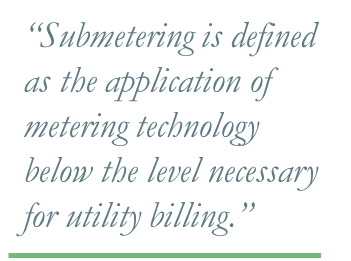System Overview
Utility meters are devices to measure and record the consumption of utilities such as electricity, water, natural gas, and steam. Main utility meters measure the total consumption for an entire building or property. Submeters are additional meters installed to measure utility consumption in more detail, whether for a specific area, system or device, and are often used in multi-tenant buildings, commercial spaces and industrial facilities to allocate utility costs accurately and fairly among different users.
By measuring more detailed consumption information for different buildings in a multi-building campus, different floors of the same building, different tenants in a multi-tenant office or facility, individual building systems, electrical circuits, or even specific devices, submeters can offer a powerful insight into a building's resource use, which helps to identify building inefficiencies, meet performance goals, and improve occupant awareness. Data from well-designed submetering systems can guide management strategies that result in significantly reduced energy and greenhouse gas emissions in buildings and portfolios. As the saying goes, “what gets measured gets managed.” Check out the Submetering Wizard to learn about submetering features and benefits by submeter type.
Submetering Components
- Submeter Levels
Benefits Summary
Submeters provide the data needed for establishing a baseline and allow for benchmarking against performance standards and optimized operations and maintenance programs via fault detection and diagnostics (FDD) and energy conservation measures (ECMs). Choosing the right submetering placement for a building is largely determined by the anticipated benefits that help to meet performance goals. Below are the five main benefit categories that can be realized through an effective submetering program.
- Economic Benefits: O&M changes informed by submeter data can result in improved asset management and utilization, savings due to increased system or energy efficiency, and/or reduced costs. In addition, submetering systems provide more accurate billing and revenue capture.
- Reliability Benefits: Provide early indications of pending or actual equipment failure, allowing for proactive O&M measures that can decrease power interruptions and malfunctions and improve power quality.
- Environmental Benefits: Lessen the impact on the internal and external environment, and reduce the impact on tenant or occupant health.
- Security Benefits: Enhance the security of data and physical property, and reduce the risk of physical hazards to personnel.
- Behavioral Benefits: Heighten occupant energy consumption awareness.
Many of the uses and benefits of submetering data can also be combined to achieve maximized outcomes and savings.
Installation
What can be submetered?
In a building, various utilities and systems can be submetered to measure individual consumption and usage. Submetering data provides additional granularity on resource usage, which can help with energy efficiency, cost allocation, identifying areas for improvement and reporting goal attainment.
| Electricity | Electricity usage for individual floors, units, or specific equipment like HVAC systems, lighting, or appliances. |
| Water | Water usage for individual floors, units or building systems. |
| Natural Gas | Natural gas usage in commercial kitchens, water heaters, or other gas-consuming equipment. |
| Heat | Energy consumption from heating systems. |
| Cooling | Energy consumption from cooling systems, such as air conditioning units. |
| Chilled Water | Chilled water usage in large buildings with central cooling systems. |
| Steam | Steam usage in industrial facilities or large commercial buildings that use steam for heating or industrial processes. |
| Lighting | Energy consumption from lighting systems. |
| Tenant Space | Utility consumption from individual tenant spaces or rental units. |
| Equipment | Energy consumption from specific equipment, such as pumps, fans, elevators, or industrial machinery. |
Metering Best Practices
Metering best practices involve the effective and efficient use of meters to measure and monitor various utilities and resources within buildings, facilities, or processes. These practices aim to ensure accurate data collection, promote energy efficiency, support sustainability initiatives, and optimize resource management. Here are some metering best practices:
- Comprehensive Metering Plan: Develop a comprehensive metering plan that identifies the key utilities and resources to be measured. Consider installing meters for electricity, water, gas, thermal energy, and any other relevant resources to gain a complete understanding of resource usage.
- Select Appropriate Meters: Choose meters that are suitable for the specific application and utility being measured. Consider factors such as accuracy, measurement range, and compatibility with existing monitoring systems.
- Regular Calibration: Regularly calibrate meters to ensure accurate measurements. Calibrations should be performed according to manufacturers' guidelines or industry standards.
- Real-time Monitoring: Implement real-time monitoring systems to capture and analyze meter data continuously. Real-time monitoring allows for prompt identification of anomalies and swift response to potential issues.
- Data Analysis and Reporting: Analyze meter data regularly to identify trends, consumption patterns, and potential areas for improvement. Create reports and dashboards to communicate findings to stakeholders.
- Submetering: Consider submetering specific areas, departments, or processes to gain granular insights into resource consumption and enable cost allocation.
- Energy Audits: Conduct regular energy audits to evaluate energy usage and identify energy-saving opportunities. Metering data is essential for conducting accurate energy audits.
- Benchmarking: Compare metering data against industry benchmarks or historical data to assess performance and set targets for improvement.
- Automation: Integrate metering systems with building management or energy management systems to automate data collection and analysis processes.
- Training and Awareness: Provide training to personnel responsible for metering and data management to ensure proper operation and maintenance of meters. Raise awareness among occupants and users about the importance of resource conservation.
- Data Security and Privacy: Ensure data security and privacy measures are in place to protect metering data from unauthorized access or tampering.
- Continuous Improvement: Regularly review and evaluate metering practices to identify opportunities for improvement and optimize metering strategies.


